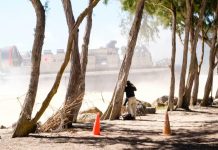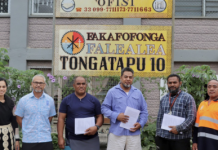In Fiji, the climate crisis means dozens of villages could soon be underwater. Relocating so many communities is an epic undertaking. But now there is a plan – and the rest of the world is watching
By Kate Lyons
For the past four years, a special government taskforce in Fiji has been trying to work out how to move the country. The plan it has come up with runs to 130 pages of dense text, interspersed with intricate spider graphs and detailed timelines. The document has an uninspiring title – Standard Operating Procedures for Planned Relocations – but it is the most thorough plan ever devised to tackle one of the most urgent consequences of the climate crisis: how to relocate communities whose homes will soon be, or already are, underwater.
The task is huge. Fiji, which lies in the south Pacific, 1,800 miles east of Australia, has more than 300 islands and a population of just under 1 million. Like most of the Pacific, it is starkly susceptible to the impacts of the climate crisis. Surface temperatures and ocean heat in parts of the south-west Pacific are increasing three times faster than the global average rate. Severe cyclones routinely batter the region. In 2016, Cyclone Winston hit Fiji, killing 44 people and causing $1.4bn of damage, a third of Fiji’s GDP. Since then, Fiji has been hit by a further six cyclones. Five of the 15 countries most at risk from weather-related events are in the Pacific. Fiji is number 14.
What Fiji is attempting to do is unprecedented. For years, politicians and scientists have been talking about the prospect of climate migration. In Fiji, and in much of the Pacific, this migration has already begun. Here, the question is no longer if communities will be forced to move, but how exactly to do it. At present, 42 Fijian villages have been earmarked for potential relocation in the next five to 10 years, owing to the impacts of climate crisis. Six have already been moved. Every new cyclone or disaster brings with it the risk of yet more villages being added to the list.
Moving a village across Fiji’s lush, mountainous terrain is an astonishingly complex task. “We keep on trying to explain this,” Satyendra Prasad, Fiji’s ambassador to the UN, told the Guardian last year. “It is not just pulling out 30 or 40 houses in a village and moving them further upfield. I wish it were that simple.” He rattled off a list of the things that need to be moved along with homes: schools, health centres, roads, electricity, water, infrastructure, the village church. “And in case even that you were able to achieve, you have to relocate people’s burial grounds. Try doing that.” If anything, Prasad was understating the challenges, which are not just logistical – though that element is hard enough – but also financial, political, even spiritual.
The Standard Operating Procedures document is in the final stages of consultation and will soon go before Fiji’s cabinet for approval. “No other country, to the best of my knowledge, has progressed as far in their thinking about how to make planned relocation decisions at a national level,” says Erica Bower, an expert on planned relocations, who has worked with the UN and the Fijian government. “These are questions that so many governments around the world are going to be asking in the next 10 years, 20 years, 50 years.”
1 The first relocation: a (partial) success story
Vunidogoloa, a village of about 140 people on Vanua Levu, the country’s second-biggest island, has an unfortunate prestige in Fiji. It was the first place to be relocated due to the climate crisis. As it is, in a sense, proof of concept, the village has received a lot of visitors over the years. Sailosi Ramatu, who often takes them on a tour of the new and old village sites, has his spiel down pat.
Ramatu, 62, was the village headman in 2014, at the time of the move. Vunidogoloa is two hours’ drive from the island’s main town of Labasa, and when I visited recently, he showed me around the old village. This was where Ramatu was born, where he always imagined he would die. Now it is a ghost town. About 20 abandoned houses are still standing, wind whistling through their open doors and broken louvres. The roofs are falling in, floorboards are missing, everything is overgrown. What would once have been a lush grass clearing where people met to eat and drink is now a swamp.
Discussions about moving Vunidogoloa started in earnest around 2004. Two years later, the community approached the provincial government and requested assistance with relocation. It took the better part of a decade before the new site, about a mile farther inland and higher up, was ready for them.
Moving was a decision of the very last resort. The village had adapted until it could adapt no more. Down on the sand beach at the old village site, Ramatu showed me concrete blocks sticking out from the sand: the footings of his old home. Over the decades, as the water advanced, his family had moved the house back once, then again. He pointed out the remains of a sea wall three or four metres offshore. It was the second built for the village, after waves and storms destroyed the first. It, too, became useless.
The idea of moving the village had been discussed since the 50s, when the sea level started rising, and so the community felt it had the blessing of past generations. Even so, it was painful to leave, and especially painful to leave the dead behind. “We left our grandparents, we left our parents, we left everything. [When] we moved that day, [it] was like moving as foreigners to a foreign land. People packing their bags, they were loaded on to a truck … they cried before they left their house, because that was the last time.”
The new Vunidogoloa consists of 30 pale green houses dotted across an impossibly green hillside. In Sera Naidrua’s house on the day I visited, colourful fabric hangings covered the walls and a cool breeze ran through the open windows and doors. She had laid a green gingham cloth on the floor, on which she had set plastic buckets holding cutlery, and coloured glass plates, which stood ready for lunch: rourou (taro leaf cooked in coconut milk) and cassava. A ginger cat sat by her side.
As Naidrua, who is 74, poured cold tea into bright plastic cups, she spoke emotionally about the old village. She recalled, as a child, picking the fruit of the dilo tree, which grew along the coast at the old site, and using them to play marbles. But ultimately, she said, “It was a good decision relocating here.” Before, she said, “We were fearing for our lives because of cyclones, inundation of waves in the village.” Now, “We feel safer here.”
To relocate, a community ideally needs two things. “The village must have the land, and second they must have the resource: timber, gravel, rocks, sand,” said Simione Botu, the current headman. “If not … trouble.” In these respects, at least, Vunidogoloa was lucky. Villagers didn’t have to negotiate with a neighbouring clan or with the government for land to move to. They already owned land, within mataqali (clan) boundaries, that was deemed safe for a new village to be built on. The clan also owned forest that could provide timber for the houses. So, while the Fijian government funded a large part of the relocation, and the International Labour Organization provided some funding to pay labourers for the construction, the village contributed much of the resources.
Even so, mistakes were made. Speak to people working on Fiji’s relocation guidelines, and one omission in particular comes up time and time again. The houses at the new Vunidogoloa site were all built without kitchens. The initial government plan was that each house was to have a separate external kitchen, to be built during a second building phase, after the main house structures were finished, but that that never happened. Eventually, villagers built their own kitchens, some using salvaged material from the kitchens of their homes in the old village.
Makereta Waqavonovono, from Climate Tok, an organisation that does climate crisis education work with rural communities, said that what this blunder points to is something more fundamental than just a lack of funding or an incomplete building project: a failure to consult the entire community, rather than with just a few male village leaders. “One of the most glaring parts of it is that they forgot to put kitchens in,” she said when asked about the lessons have been taken from the Vunidogoloa relocation. “Now, what does it say? It means that women were not involved.”
The new site has also brought new problems. It is near a road, which allows villagers easy access to bigger towns for healthcare and schooling, but the ease of travel has also meant the arrival of alcohol, in a previously dry village, and what Botu called “criminal behaviour”. After relocation, the village set up a committee to police the village’s bylaws, particularly around alcohol consumption, noise complaints and antisocial behaviour – problems Botu said they didn’t have before. The new site is inland, which makes fishing, a part of daily life and a key part of the villagers’ diet, harder. Many villagers, Naidrua said, still walk down to the old site to fish two or three times a week.
Still, Naidrua said that most people agree the benefits of the move outweigh the disadvantages. The new houses have septic tanks, solar panels and flushing toilets. Each family has its own home, whereas at the old site, two or three families would share each dwelling. It is much easier to grow food here, away from the boggy, salinated soil. It is, for the most part, a success story, an example of relocation done well.
2 ‘Draft Zero’: how to start planning a move
There aren’t many people who know the details of the Standard Operating Procedures better than Leba Gaunavinaka, a technical specialist at Fiji’s ministry of climate change. As we spoke on Zoom, she shared numerous sprawling graphs that showed the steps required for relocation. They had the flavour of a choose-your-own-adventure novel: if the land is iTaukei, or indigenous-owned, then the request for relocation goes to the district advisory council. If the land is not indigenous-owned, then the request goes to the Ministry of Housing and Community Development. If the community is judged to be at risk of earthquakes or landslides, the risk assessment of the land should be carried out by the Mineral Resources Department. If the risk is cyclones, then it’s done by the Fiji Meteorological Office. The aim is to anticipate every eventuality.
The SOP has gone through countless redrafts since late 2020, when Draft Zero was launched. Draft Zero was the result of extensive discussions between a consultant from GIZ, the German government’s main development agency, the international partner coordinating SOP consultations, and the Fiji government. After two years of further consultations and discussions, the SOP is tailored to the situation on the ground. Recent experience has also been woven in. “We’ve had six communities that have been relocated so far,” Gaunavinaka said. “And there are lessons learned from those that have been factored into the SOP.”
One example of the way the SOP has evolved is on women’s involvement in the relocations. “It’s so easy for outsiders to come and say that all decisions should include a woman,” said Christine Fung, from GIZ. “And then the process carries on and you see that women are saying ‘yes’ in meetings, but if you dig deep into this, actually, you know, sometimes it’s not a true representation of the women’s voice … Because culturally, most women defer to the men to speak.”
The SOPs have tried to address that, Fung said, by deliberately and separately consulting women – as well as other groups in the community – about a potential relocation, and requiring not just that 90% of village residents, but 90% of men, 90% of women, 90% of elderly people, 90% of young people, 90% of LGBTQ residents and 90 percent of community members with a disability must each give their approval before any assessments or discussions with government can begin about relocation.
The makers of the SOP often describe it as a “living document”. In August, leaders of civil society organisations, church groups and NGOs met in a conference room in downtown Suva, the capital of Fiji, to kick the tyres of the plan, including role-playing how they would communicate certain sections of it to communities to try to anticipate pitfalls. “I mean, every month a new experience comes up, and then it’s like, OK, let’s call a meeting and discuss how best this can be addressed in the SOP so it doesn’t happen again,” said Fung. “Because these experiences are living experiences, and because it has a human element to it, it keeps changing.”
The government hopes that the SOP will resolve the uncertainties of the relocation process. Until now, whether a village was eligible to move – and the ultimate success of a move – depended a lot on the influence of their village leaders. “It was really at the discretion not just of the village headman, but also those government bodies and agencies [responsible for relocation],” said Vani Catanasiga, executive director of the Fiji Council of Social Services, an NGO that has been consulting on the government’s relocation plan.
Under the SOP, the process will be standardised. Once consent is given, the government begins a series of assessments to establish the needs of the community and the level of threat, and to survey the available land. All adaptation options are explored: reclaiming surrounding areas, dredging riverbeds, raising the houses on stilts, improving drainage. Only then, when every alternative measure has been ruled out, after extensive consultation with the community, can any action occur.
But even when everyone agrees that relocation is essential, the process can still be undone by two things: access to money and access to land.
3 A village in limbo: ready to move – but where to?
For the people of Nabavatu, the problem has been land. Until last year, no one there had considered relocating. The village, which is built on a hill on Vanua Levu island, overlooking the mighty Dreketi river, had not experienced the slow creep of sea level rise, the gradual poisoning of its land. Then, in January 2021, it was hit by Cyclone Ana. “This is the first cyclone I ever met during my life,” said Eseroma Lava, 66, the assistant headman for the village. “I was really scared that day.”
Eighteen months after the cyclone, the old village was still a scene of destruction. The village hall, which was supposed to be the evacuation centre in the event of a cyclone, was wrecked. Its ceiling had caved in, and its windows and shutters were blown out. In the wake of the cyclone came torrential rain, which turned the hill to mud and caused the land underneath the homes and roads and buildings to slip. Most of the buildings, including the church at the top of the hill, painted in bright pastels – the crowning glory of the village – developed deep cracks from the foundations up to the roofs. When a team of government surveyors came, they told villagers that the ground was too unstable for them to remain. They had to leave, for good.
When I visited in July, the villagers – nearly 400 people – had been living in disaster tents for well over a year. These 38 tents sit in the grounds of an Assemblies of God church. There is no electricity connected to the site, though villagers have access to small solar batteries that give them some power when the sun is shining. To continue reading or doing schoolwork after night has fallen, children use the torches on their phones, if they have them. Water supply is patchy, and there aren’t enough toilets. “All 38 tents here use the church toilet – three for the ladies, three for the men,” said Lava with a sigh.
It was sunset, and Lava’s daughter, Laisana Bilosiliva, had just bathed her toddler in a concrete sink in the makeshift kitchen outside her tent. Seven adults and six children were sharing the tent. Privacy was an issue, but the main challenge was the heat, said Bilosiliva. During the day, the tents are too hot for children to be in safely, so she spends a lot of the day with her daughter outside, in the shade of a mango tree. At night, though, the tents are freezing cold.
No one disputed that Nabavatu needed relocation. The problem was that it had no suitable land within its clan boundaries. But just before my visit, nearly a year and a half after they were told to leave the old site, the village and government had reached an agreement over a five-hectare plot of state land down the road from where they are temporarily living. (Lava did not say why negotiations had taken so long.) Stuck in the ground at the spot where the new village will be was a new hand-painted sign: “Nabavatu relocation sponsored by Fijian government in consultation with the Nabavatu trust. A climate change project.”
Despite having secured the land, at time of writing, Nabavatu is no closer to having a new village to move into. Lava had been hopeful that logging would soon start on some of the village’s forest to provide timber for the houses that need to be built. He has been told the logging will take about 18 months, but as of late October, it still had not begun.
4 The ‘Tukuraki experience’: how things can go wrong
Every village on the list of 42 in need of urgent relocation will face this question of land. Indigenous land cannot be bought or sold in Fiji, though one clan can reach an agreement with another to allow it to use some land for a new village site. There is no money involved in such arrangements. “There’s no monetary expectation,” said one source involved in the relocation process. “In our culture it’s not something that we – that would be … ” She started to laugh at the absurdity. “You’re giving it to a family unit or a village to occupy because they are in need. It’s usually an area that you’re not even occupying. It’s actually seen as a boost that you would do that, to strengthen ties with neighbouring clans.”
But the absence of a financial agreement can sometimes make things more complicated. In 2017, Tukuraki, a village in the highlands of the main island of Viti Levu, relocated to a neighbouring clan’s land, after a series of disasters. In January 2012 a landslide had struck Tukuraki, killing a family, including two toddlers. Later that year, Cyclone Evan hit the village, damaging the temporary homes, destroying infrastructure and wiping out crops. Then, in February 2016, Cyclone Winston, the worst cyclone in Fiji’s history, hit, destroying or damaging the makeshift shelters the villagers had been living in, with many finding shelter in caves in the mountains.
In October 2017, a new 11-home village, on the land of a neighbouring community, was ready for them to move into. But, according to people familiar with the situation, tensions have since sprung up between the relocated Tukuraki villagers and members of the clan on whose land they now live. The latter were unhappy when they realised that the homes that had been built for the new village – with kitchens, toilets and bathrooms – were better than theirs, and that the development partners had built a fish pond, a poultry shed and bee hives so that the Tukuraki villagers could generate an income in their new village site. “I guess it’s human nature, you’ve given this land and all of a sudden you’re seeing this new community thriving, flourishing,” said Waqavonovono from Climate Tok.
Waqavonovono said the situation has been made more complicated by confusion about the terms of the agreement between the two clans, and the death of the village chief who originally made the deal with Tukuraki. People familiar with the situation told me that the groups were in the process of working things out, and just needed some time and space to do so. In July, when I visited Fiji, things were still tense, and Tukuraki leaders were not allowing any visitors.
Once again, the makers of the SOP have amended the document to address what Fung described as the “Tukuraki experience”. Now, Fung says, “the SOP also mentions that development of the host community has to be also considered when a new community is being given this development.”
5 ‘A sliver of a sliver’: the problem of finding funding
Once the land question is settled, there remains the question of how to pay for the relocation. The process is expensive, and neither Fiji’s government, nor the villages being relocated, have the money to foot the bill. Fiji’s GDP in 2021 was $4.59bn (US$2.02 billion) – down nearly 20 percent from 2019, after Covid effectively shut down the country’s all-important tourism industry overnight. That means Fiji’s current GDP is around the same amount the British government spent last year on launching “Projet Gigabit” to connect hard-to-reach UK households with next-generation broadband.
International funding, such as via the Green Climate Fund, is slim. “If you look at the amount of funding that’s being made available for [climate] adaptation,” Fiji’s climate change minister Aiyaz Sayed-Khaiyum said, “the Pacific’s allocation is a sliver of a sliver.” But the need for this funding is growing. Sayed-Khaiyum, who is also Fiji’s minister for the economy, told me that, with the need to relocate so many communities from coastal areas, the map of Fiji could look quite different in 50 years. “Sixty-five per cent of the population of Fiji lives within 5km of the shoreline,” he told me. “That’s a lot of people … You’re going to have a lot more people living in the interior.”
The government has been innovative in its attempts to find money for relocation. In 2019, it announced it had set up the world’s first relocation trust fund for people displaced by climate change. Seed funding for the trust fund came from a percentage of the income from the government’s Environmental and Climate Adaptation Levy, a range of taxes on hotels, cruise ships and ferries, bars, nightclubs, cinemas, and restaurants, as well as on incomes over FJ$270,000 (US$135,000). But the prime minister acknowledged in a speech announcing the launch on the margins of the UN general assembly in 2019 that “this is not enough”, and that Fiji would need contributions from international partners in order for the relocation trust fund to work. In February 2020, New Zealand became the first international partner to donate directly to the trust fund, contributing NZ$2m (US$1.195m).
Still, it’s clear that there simply isn’t enough money in the government pot to relocate every community that needs relocating. The Standard Operating Procedures document shows that the government is making a plan and taking a leap at the same time. Here is how it will work, the document implies. Now help us make it happen.
6 Those who leave and those who stay
When villages start to consider relocating, as well as the surveyors, the consultants, the government officials and the donors, another key group that comes in to help are theologians. “Pacific people are still deeply spiritual … and deeply connected to the land,” said Netani Rika from the Pacific Conference of Churches (PCC), an influential group that connects churches of different Christian denominations across the Pacific. “It is the land God gave your forefathers and your forefathers have given to you, and now if you are moving away, it’s a sign almost that you are giving up on your responsibility. And sometimes all they need is for the priest or for their church minister or pastor to say: look, whether you are here or up on that mountain, God is still with you. God is everywhere. God has been with you from the beginning and will accompany you on this journey also. Feel free to go.”
For many Pacific people, burial sites remain the biggest obstacle to relocation. The hardest people to move are the dead. When relocating, villagers face a choice of either leaving behind the bones of ancestors, or exhuming them and taking them to the new site. Either choice is deeply traumatic.
In a tiny settlement of half a dozen houses named Togoru, about 45 minutes drive from Suva, the local cemetery is already underwater. At high tide, fish swim around the gravestones of Lavenia McGoon’s ancestors, but McGoon, who is 70, wants to stay. According to residents, the settlement has been there since the early 1800s. Togoru is small, with about 20 people living there. Many residents come and go – some have lived and worked elsewhere in Fiji before returning, or work in other parts of the country during the week and return for weekends and holidays.
When I visited, McGoon had visitors from Australia. A boatload of children were setting off on an expedition, and a toddler was napping in a hammock stretched between palm trees in the shade. “It’s lovely, you’ll notice. It’s so beautiful, so peaceful”, she said. “I live here with my grandchildren. My husband passed away in 2013. I’m OK, I’m happy … If I want to eat fish, I just stand up here, throw my line, catch my fish. We sell coconuts and things, and that’s enough.”
The scene is idyllic – until you walk down to the shoreline, about 30 metres from where the road ends at the entrance to the settlement. McGoon is waging a desperate one-woman war against the ocean. She has scattered the beach with old tyres filled with rocks so the waves at high tide won’t break with such force on the land.
Togoru loses an estimated 1.5 metres of land every year. But, in the first six months of 2022, McGoon said they had already lost five metres. McGoon did not put the damage down solely to climate breakdown. She said the damming of a nearby river, done so that land near the settlement could be used for rice farming, has also played a role. “You know, you want to go against nature, this is what will happen. And once the ocean gets mad, that’s it,” she said.
The waterlogged cemetery is perhaps the starkest symbol of the losses that have been suffered. “Everywhere [in the world], the cemetery, the dead, the loved ones, they are special and they are well looked after,” said McGoon. “But it’s so sad to see them, to see the cemetery like that.”
Togoru is not slated for relocation. It is not on the list of 42. The government has repeatedly raised the option of relocation with the community, but the residents have stressed that they do not wish to move. The government has promised McGoon another sea wall, after the first was defeated by the waves. She wants to stay until she dies. “I’m too old to start all over again,” she said.
After she is gone, she doesn’t see a future for Togoru. “I’m telling my grandchildren: try to be better off. Go to school, achieve your goals, work, earn money and bugger off overseas, that’s all. Because, you know, we can see what’s really happening.” .
SOURCE: THE GUARDIAN/PACNEWS


















